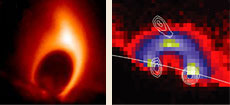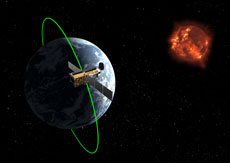Hinode is Japan's third solar Observation. The first one, built entirely in Japan, was the satellite Hinotori, launched in 1981. It performed solar-flare Observation with a hard X-ray telescope. The second, Yohkoh, was launched in 1991, and successfully imaged scenes of dynamic solar activity using soft and hard X-ray telescopes. Half of its Observation instruments were developed through international collaboration, which continued through post-launch operations and data analysis. Thanks to these experiences with Yohkoh, cooperation on Hinode is going well.
Yohkoh continued its mission until December 2001 - for ten years and three months - observing for the first time almost a complete 11-year solar activity cycle. Among its many remarkable scientific achievements is the discovery of a dynamic solar corona, which completely changed our traditional view of the corona as quiet. It also confirmed that a solar flare is an explosive phenomenon happening in the corona and powered by magnetic reconnection, a process in which magnetic field lines from different magnetic field domains are spliced together.
The satellite made many other great discoveries, but its most significant achievement may be that its Observation data and technology have been passed on to other solar Observation satellites around the world. And of course, we shouldn't forget that Yohkoh helped us devise the concept for Hinode. For example, it found that the solar corona has something to do with magnetic fields, which inspired us to make coronal Observation more sophisticated and to equip the satellite with a telescope that can measure solar magnetic field vectors.
The data that Yohkoh accumulated over ten years is greatly valued by researchers around the world, and is still the basis of many papers being published today. Yohkoh has proven the importance of space-based solar Observations, and has launched a new era of solar physics.
The solar observatories currently operating in space are: SOHO (the Solar and Heliospheric Observation), a joint project between ESA and NASA launched in 1995; and two NASA projects: TRACE (Transient Region and Coronal Explorer, 1998); and RHESSI (the Reuven Ramaty High Energy Solar Spectroscopic Imager, 2002).
The SOHO mission is investigating the internal structure of the Sun, its outer atmosphere, and the solar explosions that blow gases into interplanetary space. TRACE is watching the solar corona with an ultraviolet telescope, and RHESSI is investigating solar-flare explosions by measuring high-energy X-rays and Gamma rays. Taking advantage of these distinct capabilities, Japanese solar scientists have made extensive use of the wonderful Observations made by these satellites. New discoveries are usually made through cooperative Observation using many telescopes, including ones on the ground. In the solar-research field, it is becoming common practice to publish data and share it with colleagues around the world. There is no need to worry about a lack of recognition for scientists who have developed great instruments. In our community, the developers of prominent telescopes earn a lot of respect, and the more their Observation data is used by other scientists, the more their reputation grows. Scientists are, of course, competitive, and I hope my Japanese colleagues on Hinode will achieve the great results they deserve. But at the same time, I believe in the importance of an international network that reaches beyond borders. Presuming that data processing will catch up, Hinode's data will start to be opened by April 2007.

Magnetic reconnection

Magnetic reconnection in the solar corona

Cusp structure at the top of a flare loop discovered by Yohkoh

Hinode flying in Sun-synchronous polar orbit (artist's rendering)
One month after launch, the Observation is scheduled to be placed into its Sun-synchronous polar orbit, following the terminator line between night and day on Earth, which will allow the satellite to observe the Sun 24 hours a day for about eight months of every year. And two months after launch, early Observation will begin, after the satellite's basic functions are tested. Our plan is to continue the mission for more than three years, performing Observations that have been proposed by Japan and by other countries as well. The volume of data from Hinode will be tens of times the amount from Yohkoh, and its quality promises to be very high. I hope that ISAS will make Hinode data accessible to all researchers around the world.